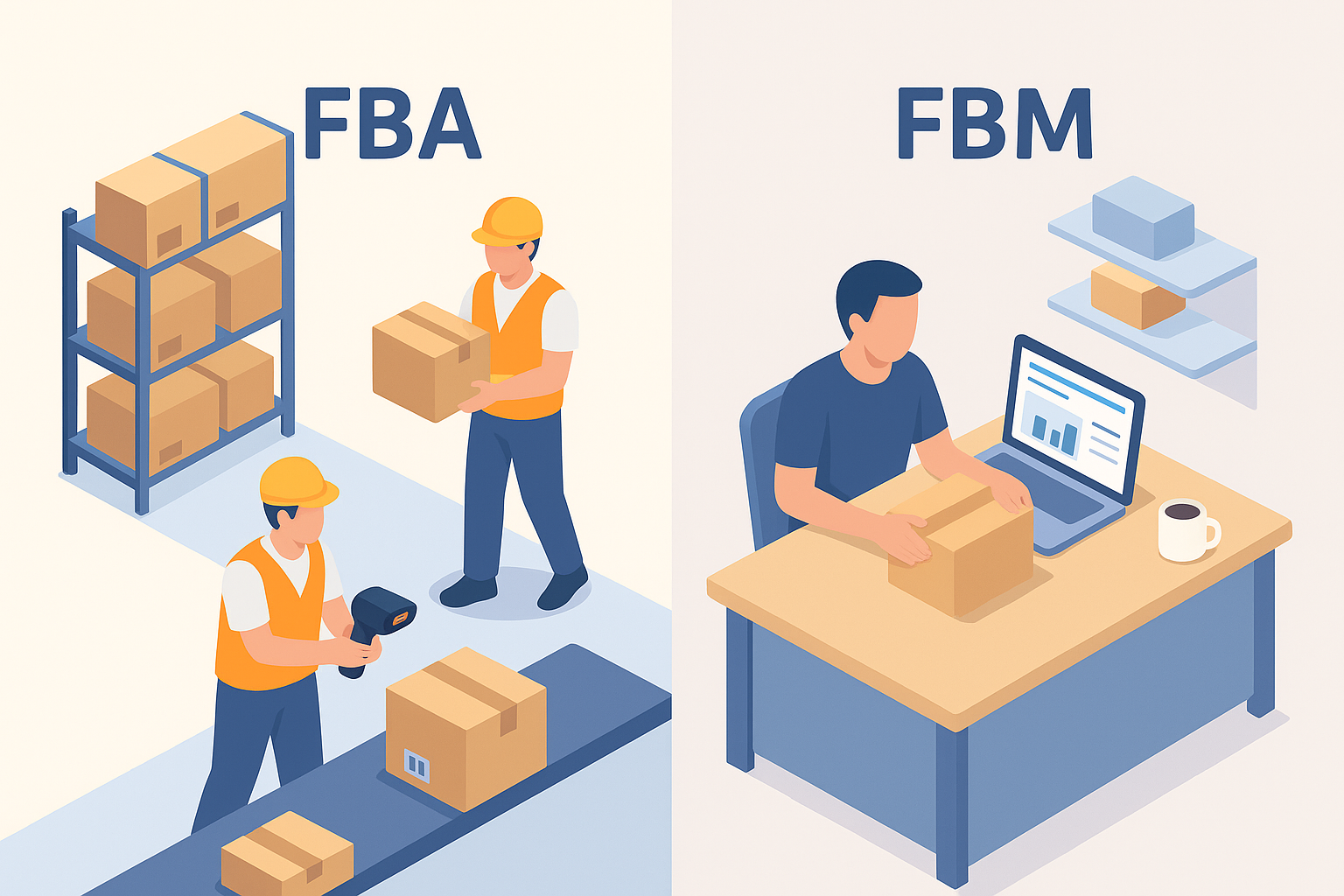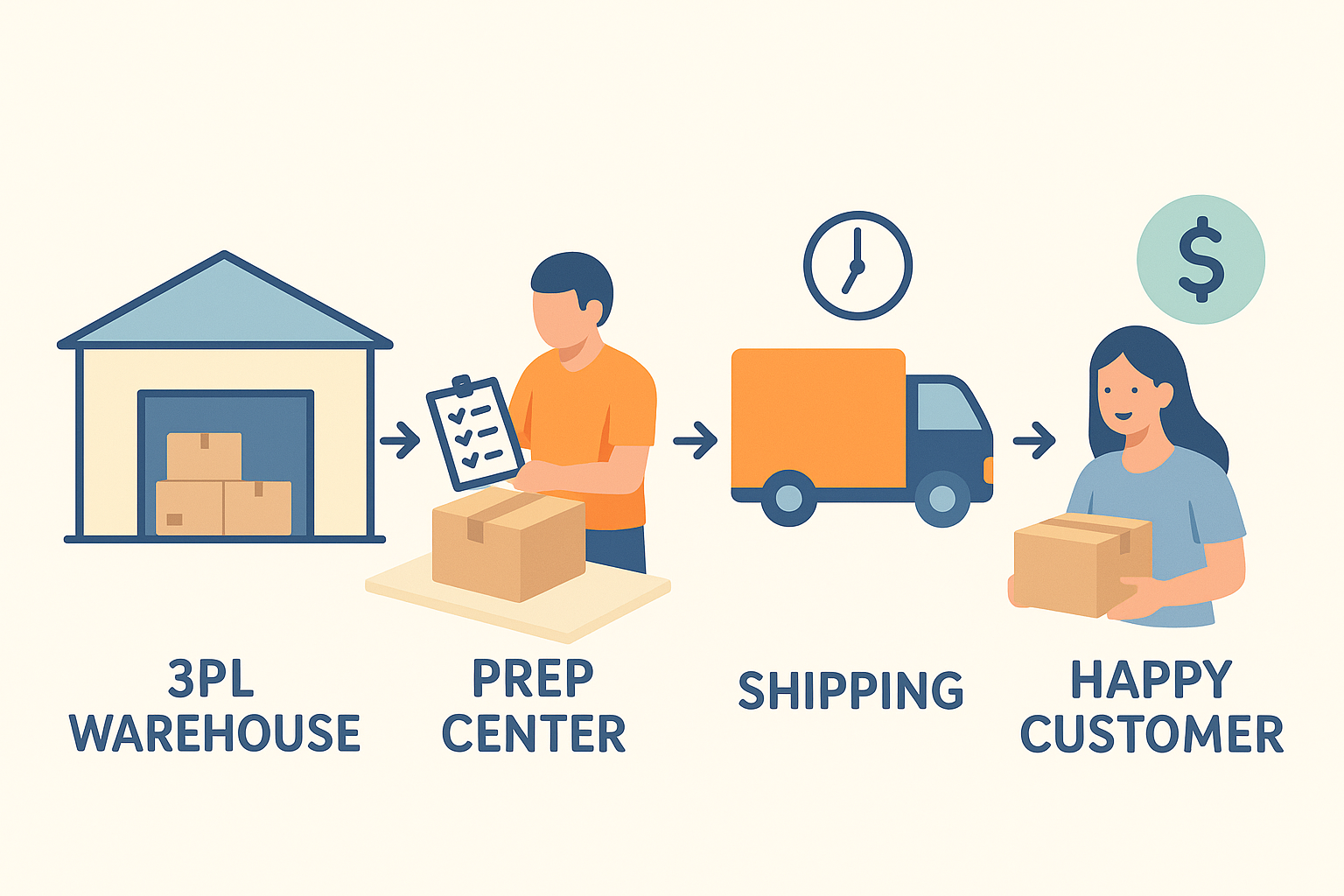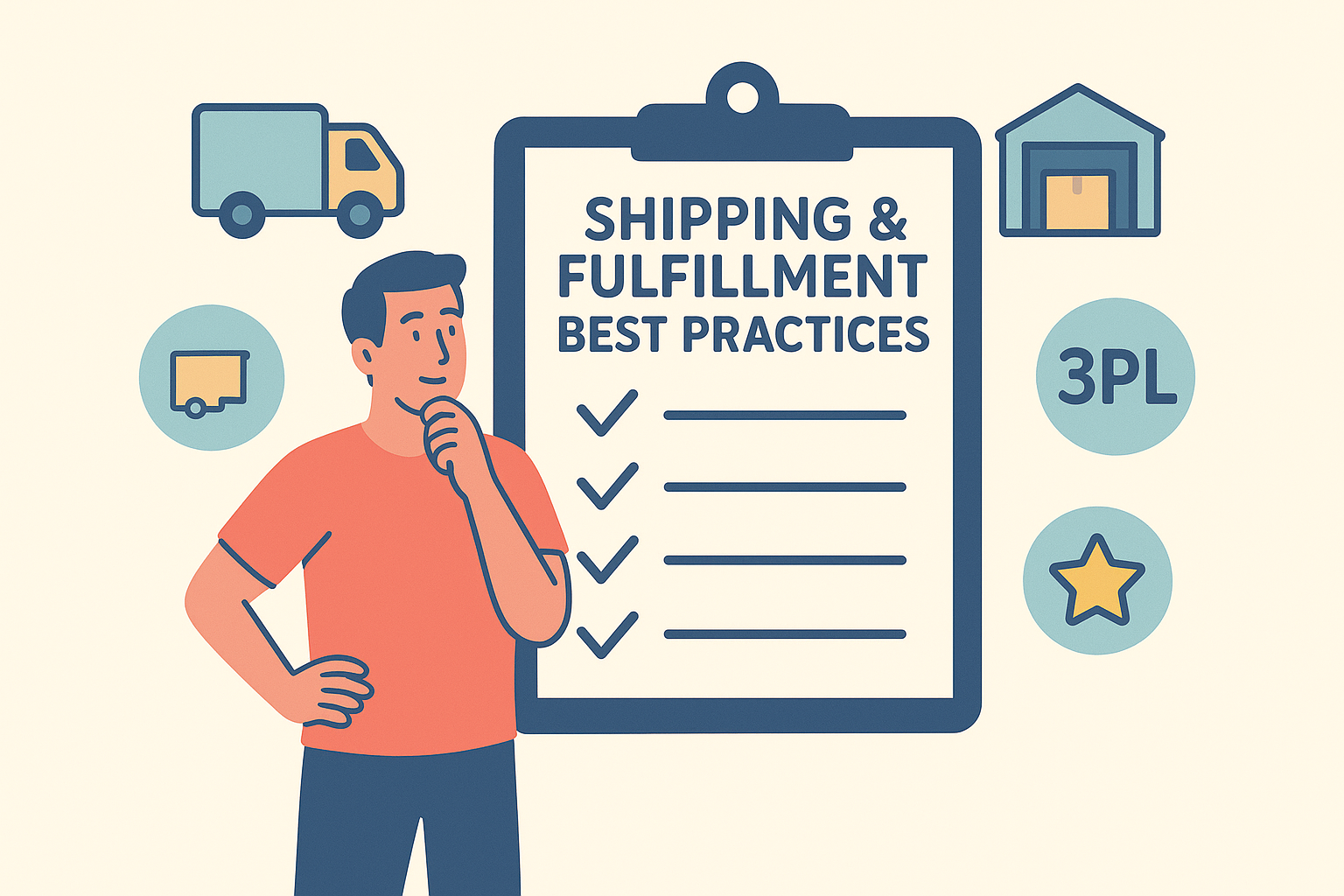Shipping & Fulfillment: FBA, 3PL, Prep Centers & FBM Best Practices
Shipping & Fulfillment Powers Growth
Key Takeaways
| Fulfillment Model | Best For | Key Advantages | Potential Challenges |
|---|---|---|---|
| Amazon FBA (Fulfillment by Amazon) | Sellers chasing Prime access & scale | Fast shipping, storage, and customer service | High fees, strict prep rules |
| FBM (Fulfilled by Merchant) | Small sellers, niche or custom goods | Control, lower fees, brand flexibility | Slower delivery, more seller work |
| 3PL (Third-Party Logistics) | Scaling shops across Amazon, Walmart, and Shopify | Multi-channel fulfillment, flexibility | Hidden costs, contract issues |
| Prep Centers | Amazon/Walmart high-volume sellers | Compliance help, FBA prep, less stress | Extra fees, reliance on others |
Introduction
Running an online store isn’t just about selling cool gear. It’s about how fast and smoothly you can get packages from your shelf to the shopper’s door. Customers now expect Amazon Prime speed, even if they’re buying from Walmart Marketplace, Etsy, or a small Shopify shop.
That’s where fulfillment comes in. Models like Amazon FBA, FBM, third-party logistics (3PL), and prep centers are the engines of eCommerce. Each one comes with perks and quirks. Some give you speed, some give you control, and others let you scale up without drowning in boxes.
Think of it like cars. You can drive a compact car (FBM), hop in a Tesla with autopilot (FBA), hire a pit crew for racing (3PL), or get a dedicated garage crew to prep your car before each run (prep centers).
This article breaks down these models, lays out best practices, and shows how smart sellers—from Amazon private label brands to Walmart resellers—choose fulfillment to boost sales and cut headaches.
1. Core Understanding of Fulfillment
What are the top shipping and fulfillment strategies for e-commerce sellers?
eCommerce sellers like Amazon merchants, Walmart suppliers, and Shopify store owners all face the same challenge: fast, reliable delivery. The top strategies usually include:

-
Using Amazon FBA for scale and Prime badge visibility
-
Running FBM for control on unique or fragile items
-
Outsourcing to 3PL partners for multi-channel growth
-
Leaning on prep centers to handle compliance, bundling, and packaging
How to decide between FBA, FBM, 3PL, or prep centers?
The choice depends on:
-
Budget (fees, shipping costs, storage)
-
Product type (fast movers vs. slow movers, bulky vs. small)
-
Sales channels (Amazon-only, or multi-channel like Shopify + Walmart)
-
Growth goals (testing, scaling, global expansion)
Table: Comparing Core Fulfillment Paths
| Model | Best Suited For | Key Trade-Off | Example |
|---|---|---|---|
| FBA | Scale + Prime | Higher costs | Amazon sellers |
| FBM | Small + niche | Slower speed | Etsy crafters |
| 3PL | Multi-channel | Contracts | Shopify brands |
| Prep Centers | High volume | Extra layer | Walmart sellers |
Bullet List – Core Tips
-
Always measure cost per unit shipped
-
Track customer delivery expectations
-
Test one model before scaling to multiple
-
Use analytics from Amazon Seller Central or Shopify dashboards
2. Fulfillment by Amazon (FBA)
What are the best practices for Amazon FBA shipping and fulfillment?
Amazon FBA lets sellers send inventory to Amazon warehouses. From there, Amazon Logistics handles picking, packing, shipping, returns, and customer service. Best practices include:
-
Send products in compliance with FBA packaging standards
-
Monitor storage fees to avoid long-term charges
-
Use inventory forecasting tools
-
Keep an eye on IPI score (Inventory Performance Index)
What packaging guidelines should sellers follow for FBA?
-
Use poly bags, bubble wrap, or cartons based on item type
-
Print scannable barcodes (FNSKU)
-
Follow Amazon ASIN-level prep rules
How to optimize inventory management for FBA shipping?
-
Track demand using Amazon Seller Central reports
-
Restock in smaller, frequent shipments to avoid long-term fees
-
Use replenishment alerts
What is the cost structure of Amazon FBA fulfillment services?
Costs break into:
-
Fulfillment fees (pick, pack, ship per unit)
-
Storage fees (monthly + long-term)
-
Optional services (labeling, prep, removal)
How does Amazon FBA compare to FBM in terms of shipping efficiency?
-
FBA: Faster delivery, Prime badge, higher trust
-
FBM: Lower costs, slower shipping, more work
Table: FBA Costs Breakdown
| Fee Type | Example | Named Entity |
|---|---|---|
| Fulfillment | $3.22 per unit | Amazon FBA |
| Storage | $0.87 per cubic foot | Amazon Logistics |
| Labeling | $0.30 per unit | Amazon Prep Service |
Bullet List – FBA Best Practices
-
Always label correctly with FNSKU
-
Avoid overstocking during slow months
-
Track Prime shipping speed promises
-
Audit Amazon fee reports monthly
3. Fulfilled by Merchant (FBM)
What is FBM, and how does it differ from FBA?
FBM (Fulfilled by Merchant) means the seller ships orders directly, not Amazon. Unlike FBA, sellers handle storage, packaging, and returns.
What are the advantages of FBM for small sellers?
-
Lower fees vs. Amazon FBA
-
More control over packaging and branding
-
Works for unique, handmade, or bulky products
How to handle shipping and fulfillment with FBM effectively?
-
Use carriers like UPS, FedEx, DHL
-
Automate labels with tools like ShipStation
-
Keep backup stock ready for spikes
What tools help sellers streamline FBM order management?
-
Amazon Seller Central order reports
-
ShipBob integrations
-
Shopify fulfillment apps
How does FBM affect customer satisfaction and shipping times?
-
FBM may ship more slowly than Amazon Prime
-
But sellers can add personal touches to packaging
-
Customer loyalty grows when branded right
Table: FBM vs FBA Performance
| Factor | FBM | FBA | Named Entities |
|---|---|---|---|
| Speed | 3–7 days | 1–2 days | UPS, Amazon Prime |
| Cost | Lower | Higher | FedEx, DHL, Amazon |
| Branding | Custom | Standardized | Shopify sellers |
Bullet List – FBM Tips
-
Negotiate carrier rates with UPS or FedEx
-
Offer tracking via Amazon Seller Central
-
Keep packaging professional
-
Set clear return policies

4. Third-Party Logistics (3PL)
What is 3PL in eCommerce fulfillment?
3PL (Third-Party Logistics) providers like ShipBob, Rakuten Super Logistics, or Red Stag Fulfillment store, pack, and ship products for sellers across platforms.
How to choose the best 3PL provider for Amazon and Walmart sellers?
-
Check the location of warehouses
-
Review integrations with Amazon, Walmart, and Shopify
-
Compare service-level agreements (SLA)
What are the pros and cons of using 3PL vs FBA?
Pros: Flexible, multi-channel, branding control
Cons: Contracts, hidden fees, and less automation
How do 3PLs improve order fulfillment speed and accuracy?
-
Multiple warehouse networks reduce shipping zones
-
Advanced tracking systems reduce errors
What are the hidden costs of third-party logistics services?
-
Receiving fees
-
Kitting/bundling fees
-
Long-term storage
Table: 3PL vs FBA Overview
| Factor | 3PL | FBA | Named Entities |
|---|---|---|---|
| Channels | Multi | Amazon only | ShipBob, Amazon |
| Fees | Custom | Standard | Rakuten, Amazon Logistics |
| Branding | Custom | Limited | Shopify, Walmart |
Bullet List – 3PL Selection Tips
-
Visit 3PL warehouse sites
-
Compare SLA guarantees
-
Test integrations with the Shopify API
-
Run small trial orders
5. Prep Centers
What is an Amazon prep center, and how does it work?
Prep centers are facilities that receive, inspect, and prep goods before sending them to Amazon FBA warehouses.

What services do prep centers provide for e-commerce sellers?
-
Labeling (FNSKU)
-
Bundling sets (2-pack, 3-pack)
-
Quality control
How to select a reliable prep center for FBA shipments?
-
Look for experience with Amazon compliance
-
Check turnaround speed
-
Compare per-unit fees
What are the best practices for working with prep centers?
-
Maintain communication on shipment timelines
-
Send SKU-level instructions
-
Audit shipments quarterly
How do prep centers reduce shipping errors and delays?
-
Catch product defects early
-
Ensure Amazon-compliant packaging
-
Lower rejection rate at FBA warehouses
Table: Prep Center Services
| Service | Example | Named Entities |
|---|---|---|
| Labeling | FNSKU stickers | Amazon Prep Center |
| Bundling | 3-pack kits | FBA sellers |
| QC | Inspection | Amazon FBA Warehouse |
Bullet List – Prep Center Tips
-
Share shipment plans early
-
Use Google Sheets for SKU instructions
-
Visit once if possible
-
Rotate providers if errors rise
6. Best Practices Across All Models
How to lower shipping costs without compromising speed?
-
Negotiate carrier rates with FedEx, UPS, and DHL
-
Use zone skipping via 3PLs
-
Leverage Amazon’s partner carrier program
What is the role of automation in fulfillment best practices?
-
Automate inventory alerts via Seller Central
-
Use Shopify apps for syncing stock
-
Deploy EDI integrations
What are common mistakes sellers make in fulfillment and shipping?
-
Overpromising shipping speeds
-
Ignoring returns policies
-
Overstocking slow movers
Table: Cost-Saving Tips
| Method | Savings | Named Entities |
|---|---|---|
| Zone skipping | 10–20% | UPS, FedEx |
| Partner carrier | 5–15% | Amazon Logistics |
| Multi-warehouse | 8–12% | ShipBob |
Bullet List – Best Practices
-
Keep the customer first in mind
-
Forecast demand smartly
-
Review costs every quarter
-
Balance speed vs. price
7. Advanced & Comparative Insights
Which is better: FBA vs 3PL vs FBM for scaling businesses?
-
FBA: Easy scale, high fees
-
FBM: Control, limited speed
-
3PL: Flexibility, contracts
How do international sellers manage shipping and fulfillment?
-
Use Amazon Global Logistics
-
Partner with DHL Express or Aramex
-
Store stock in local EU warehouses
What fulfillment model offers the best ROI for Amazon sellers?
-
Small items: FBA
-
Custom brands: FBM
-
Multi-channel: 3PL
How do prep centers integrate with 3PL and FBA logistics?
-
Prep centers prepare goods, then forward them to 3PL warehouses or Amazon FBA hubs
-
Data flows via Shopify apps or EDI
What are the future trends in e-commerce shipping and fulfillment?
-
Drone delivery (Amazon Prime Air)
-
More AI-driven inventory systems
-
Growth of micro-fulfillment centers
Table: Comparative Models
| Model | ROI Level | Named Entities |
|---|---|---|
| FBA | High for fast movers | Amazon Prime |
| FBM | Moderate | Shopify sellers |
| 3PL | High for multi-channel | ShipBob, DHL |
| Prep | Support role | Amazon Prep Services |
Bullet List – Future Trends
-
AI-powered shipping predictions
-
Local fulfillment hubs
-
Sustainable packaging
-
Drone + autonomous delivery
Conclusion
Fulfillment isn’t just about moving boxes. It’s the backbone of trust in Amazon, Walmart, and Shopify sales. Whether you roll with FBA, stick to FBM, outsource to a 3PL, or lean on prep centers, the choice should match your budget, growth goals, and customer promise.
Sellers who understand the trade-offs—speed vs. cost, control vs. automation—will always stay ahead.
Call to Action Shipping & Fulfillment Best Practices
Don’t leave shipping to chance. 🚀 Take a hard look at your current setup. Ask: “Is my fulfillment helping me grow or holding me back?” Whether you choose Amazon FBA for scale, FBM for control, 3PL for flexibility, or prep centers for compliance, the right move can power up your store.
Start today. Optimize one piece of your shipping puzzle, and you’ll see the ripple effect across your whole business. Because in eCommerce, speed, trust, and smart fulfillment are everything.